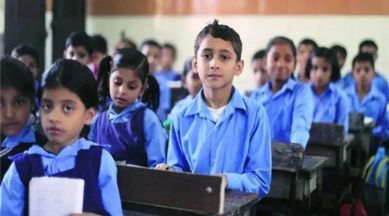Stay updated with the latest - Click here to follow us on Instagram
Online schooling hit urban poor the hardest, 1 in 5 homes say kids missed a year
Since coming to power, the AAP government has allocated a major part of its budget to the education sector — allocation for 2022- 23 is Rs 16,278 crore (23%), the highest ever.

Written by Vibha Attri and Aamir Raza
When AAP won a landslide victory in the 2015 assembly elections, one of its key promises was to transform government schools. Since then, the party has not disappointed on this front, regularly coming up with various schemes to improve the quality of education. Since coming to power, the AAP government has allocated a major part of its budget to the education sector — allocation for 2022- 23 is Rs 16,278 crore (23%), the highest ever. In part 3 of this series, Lokniti-CSDS’s study on the urban poor tries to tap into how slum residents assess the conditions of schools that their children go to.
monthly limit of free stories.
with an Express account.
Status of school going children in slums
🗞️ Subscribe Now: Get Express Premium to access the best Election reporting and analysis 🗞️
Big cities have always been hotspots for rural migrants in search of better livelihood opportunities, and a huge proportion live in slums. For children living here, a host of issues affect their education. The study shows that 8% of school going children in slums are not enrolled in any school (Table 1). Eight in ten are enrolled in a government school and 7% in private and about 3% of the families reported that some of their children are enrolled in a government school and some in private. Close to two in ten (19%) households reported that the children in their house were studying in private schools under the economically weaker section (EWS) quota.
Assessment of condition of schools
Overall there is a positive perception about the conditions of both private and government schools in the capital (Table 2). However, households having children enrolled in government schools were more likely to say that the conditions of the schools in the last 2-3 years have improved. Nearly eight of every ten reported an improvement in the condition of government schools in Delhi, while six of every ten households with children in a private school thought the condition of schools to have improved in the last two-three years.
The study also found that the children enrolled in government schools are likely to get more facilities than those admitted in private schools. Nearly 65% households having a child in a Delhi government school reported that he or she was getting lunch and basic educational facilities like uniform, books and stationery. There can be low reporting of mid-day meal since when schools closed due to Covid, the scheme came to a halt. However, it has resumed since April 1.
Non-enrolment and dropouts
Though the majority of the households stated that their children are enrolled in a school, many children in the slums have to drop out and are deprived of education due to multiple factors. Three per cent of households reported that their children are both studying and working (Table 3). Another 3% reported that children had to drop out of school to support their family financially, and one in ten reported that the children left studies due to other reasons. School closure from March 2020 made online education a necessity, resulting in many students missing out a year from school due to lack of smartphones and laptops. Close to two in ten households having children under the age of 18 years reported that children had to completely stop their studies in the last one to two years because of not having access to a mobile or a laptop.
While the AAP government has brought visible improvement in many spheres of education, focused steps are required to tackle the problems of non-enrolment and dropout among school going children in slums.
The authors are researchers at Lokniti-CSDS, Delhi. For the study, 1,080 people spread across 55 slums covering all 11 districts of Delhi were interviewed using a structured questionnaire by means of face-to-face interview method. The interviews were conducted by trained field investigators for three months (November 2021 to January 2022).